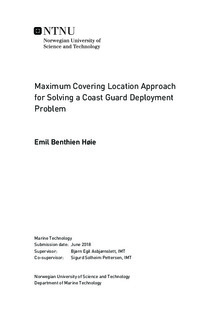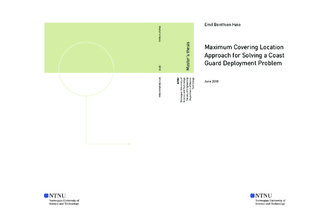| dc.description.abstract | The purpose of this thesis is to see how a maximum covering location approach can be used for solving the coast guard deployment problem. The maximum covering location method has proven to be an effective method in facility location, especially within emergency response location, which is the reason for the interest in testing the applicability to the coast guard deployment problem.
The coast guard deployment problem is a complex problem. The problem involves determining the location of a coast guard fleet with different vessel capabilities to a specific operation. Measuring effectiveness on a coast guard deployment problem suffers from missions being of non-monetary value, and operation performance is often difficult to estimate due to the lack of operational data and mission requirements.
Through a performed literature review it became clear that one of the weaknesses with the classical maximal covering location problem is the notion of "all or nothing." A demand point is either covered or not. Therefore, a modified MCLP was constructed with weighted demand nodes and weighted neighbouring nodes to simulate the value of gradual coverage. In addition, a system for diminishing marginal return on demand nodes was created to simulate the effect of coverage by multiple vessels.
A computational study is presented with two main scenarios, one with a maximum response distance for each test vessel and two where maximum response time was defined for typical coast guard missions. The model is constrained within geographical boundaries of the waters under Norwegian jurisdiction. The results show that the model is able to locate feasible solutions for vessel deployment. In addition, show how testing a great variety of fleets, with global design constraints such as maximum cost or minimum utility, can support decisions makers in search of a suitable fleet within a design space area. The result also shows that computational time increases significantly with increased coverage radius or longer response time conditions.
The coast guard MCLP are faced with limitations and simplifications related to model and data discrepancies which can compromise the accuracy of the results. A further coast guard risk analysis is therefor advised. Also, alternative objective functions such as the minimizing response time could be valuable for providing further insight into the coast guard planning problem. | |

